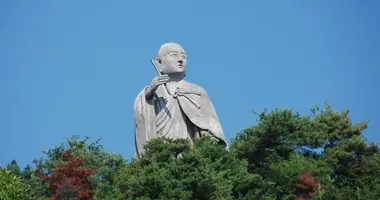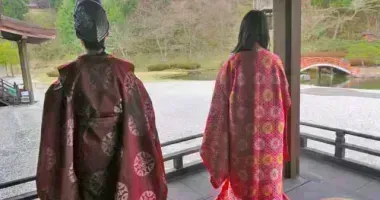Sakamoto Ryōma: The Samurai Who Helped Bring Down the Shogunate
- Published on : 27/04/2024
- by : Japan Experience
- Youtube

Sakamoto Ryōma was a key figure in Japan's transition from shogunate rule to the Meiji Restoration in the mid-19th century. Born a low-ranking samurai, he became an influential imperial loyalist working to overthrow the Tokugawa shogunate. Ryōma was a multi-faceted individual - a skilled swordsman, sailor, statesman, philosopher and businessman who left an indelible mark on Japanese history.
Early life and background
Sakamoto Ryōma was born in 1836 in Kōchi, Tosa Domain (now Kōchi Prefecture). His family were low-ranking samurai with limited opportunities for advancement under the strict class system of the time. As a youth, Ryōma showed little scholarly inclination, but excelled at swordsmanship from a young age, dedicating himself to the study of the martial arts.
Early political activism against the shogunate
In 1862, Ryōma joined the Tosa Loyalist Party, an anti-Tokugawa militant group that demanded reforms. However, he soon became disillusioned with their parochial aims. Ryōma decided to leave Tosa in 1862 to promote revolution more widely in Japan, becoming a rōnin (masterless samurai). This was a grave crime punishable by death at the time.
Ryōma initially plotted to assassinate Katsu Kaishū, a Tokugawa official, but was convinced to work with him instead. Under Katsu's mentorship, Ryōma assisted in establishing a modern navy to protect Japan from Western powers.
Negotiating the Satchō Alliance
In 1864, Ryōma fled to Satsuma Domain as the Tokugawa cracked down on dissent. There, he played a critical role in negotiating a secret alliance between the Satsuma and Chōshū domains in 1866. This unlikely alliance between two historic rivals was key in bringing down the shogunate.
As a neutral outsider, Ryōma was uniquely positioned to bridge the gap in trust between Satsuma and Chōshū. The Satchō Alliance they forged would prove to be the backbone of the imperial forces that ultimately overthrew the Tokugawa.

Portrait of Sakamoto Ryoma, Irohamaru Museum
Founding the Kameyama Shachū private navy
With Satsuma's help, Ryōma founded the Kameyama Shachū private navy and trading company in Nagasaki. This organization imported Western arms and ships to supply Satsuma and Chōshū. Some consider the Kameyama Shachū to be the forerunner of the Imperial Japanese Navy, with Ryōma playing a key role in modernizing Japan's naval capabilities.
Negotiating the Meiji Restoration
In 1867, Ryōma was recalled to Tosa Domain to help negotiate a peaceful transfer of power from the shogunate to the Emperor. He played a crucial role in convincing the lord of Tosa to persuade the Shogun Tokugawa Yoshinobu to resign. Ryōma's political blueprint, the "Eight Proposals While Shipboard", outlined his vision for Japan's modernization, including a bicameral legislature and constitution.
Assassination and legacy
Sakamoto Ryōma was assassinated by Tokugawa loyalists in December 1867, shortly before the Meiji Restoration, at the young age of 31. He died a national hero, his assassination cementing his legendary status. Ryōma was a visionary who helped pave the way for Japan's transformation into a modern state.
Ryōma studied Western government and advocated for democratic principles in Japan. His proposals are thought to have influenced the parliamentary system adopted in the Meiji era. An intriguing mix of old and new, Ryōma embodied the spirit of a nation in transition. His legacy continues to inspire the Japanese people today.

Tombs of Sakamoto Ryoma & Nakaoka Shintaro at Kyoto Ryozen Gokoku Jinja
Sakamoto Ryoma Museums & Sights
The most important museum dedicated to Sakamoto Ryōma is the Sakamoto Ryoma Memorial Museum located near Katsurahama Beach south of Kochi city. The museum opened in 1991 and has many original and replica artifacts from Ryōma's life on display, including his Smith & Wesson pistol, calligraphy, and a grisly replica of the blood-stained folding screen from the site of his murder in Kyoto.
Also in Kochi is the Kochi Municipal Ryoma's Birthplace Memorial Museum, which recreates the old district of the city where Ryōma grew up. In Nagasaki, you can visit the restored building that housed Ryōma's Kameyama Shachu trading company and naval academy.
In Kyoto, key Ryōma sites include the Teradaya Inn in Fushimi where he narrowly escaped an assassination attempt in 1866, and his grave at Gokoku Shrine.

The historic Teradaya inn in Fushimi, south Kyoto, where Sakamoto Ryoma survived an attempt on his life

Large, heavily romanticised, manga-style painting of Sakamoto Ryoma and his wife Narasaki Ryo (Oryo) being chased by the Shinsengumi, Gokoku Shrine, Kyoto
Books on Sakamoto Ryōma
To learn more about this fascinating figure, some recommended English-language books include:
- Sakamoto Ryoma and the Meiji Restoration by Marius B. Jansen
- Samurai Revolution: The Dawn of Modern Japan Through the Eyes of the Shogun's Last Samurai by Romulus Hillsborough
- Ryoma: Life of a Renaissance Samurai by Romulus Hillsborough
For more book recommendations, see our list of top books on Japanese history.
Sakamoto Ryōma's dramatic life story continues to captivate people today. This visionary samurai activist, cut down in his prime, played an outsized role in steering Japan on its rapid course from feudalism to modernityin the turbulent Bakumatsu period. Explore more famous Japanese historical figures.









